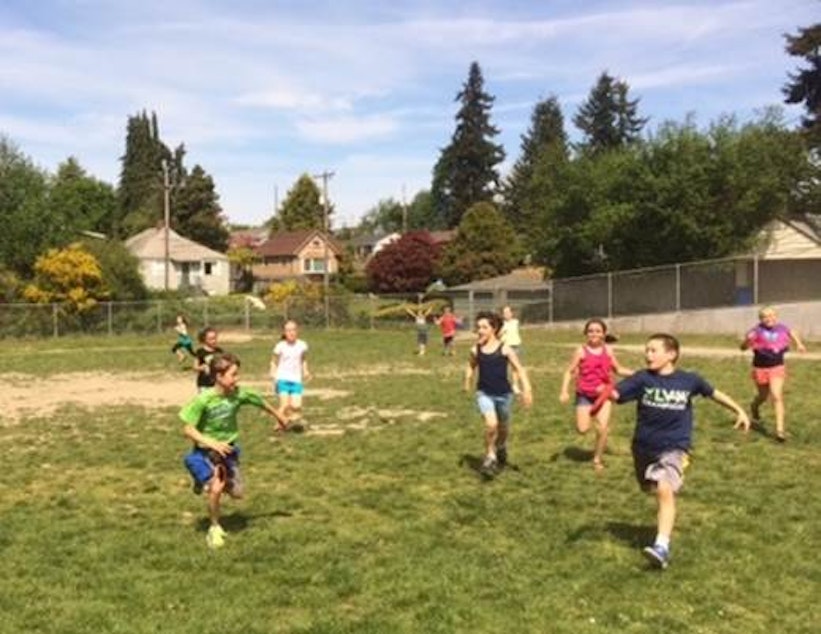Seattle-Area Kids Don’t Get Enough P.E., But Who Is Keeping Track?

At a playfield in West Seattle, physical education teacher C.J. Sealey referees with a piercing whistle. Sealey aims to get these kids moving – after all, state law demands that elementary and middle school students get at least 100 minutes of P.E. every week.
"They’re playing capture the flag, so we’re getting them to do a lot of cardio exercise without them really knowing," she said.
Sealey teaches at Schmitz Park Elementary, which for most of its grades complies with the longstanding state law. But a KUOW investigation found that few elementary schools in the Seattle area provide the required amount of P.E. In fact, not one of the eight Seattle-area school districts contacted by KUOW meets the state P.E. law.
At Bellevue Public Schools, the average is 40 minutes per week, an hour short of the state requirement.
In Highline, it’s 90 minutes.
Other districts said they’re somewhere in between.
Who is keeping track of how much P.E. students are getting? Not Olympia’s state school officials.
"We do not have a data collection mechanism in place," said Lisa Rakoz, the health and fitness education program supervisor at the Office of Superintendent of Public Instruction.
Rakoz said that although she doesn’t have any data, she hasn’t heard of districts that are out of compliance with the P.E. law.
"We trust that school districts will comply with all of the rules and regulations," Rakoz said.
Value Of Exercise
"I think your findings are concerning and disturbing for several reasons," said Dr. Pooja Tandon, a pediatrician at the Seattle Children’s Center for Child Health, Behavior and Development.
Despite record rates of childhood obesity, Tandon said cutbacks of P.E. and recess are ongoing nationwide.
That's a big problem, Tandon said, because along with the value of exercise for kids’ physical health, there’s increasing evidence that exercise makes a big difference academically, too.
"There are studies that have shown that students who are more physically active pay better attention at school,” Tandon said.
Even so, many teachers say as schools have been held more accountable for student test scores in subjects like reading and math, untested subjects like P.E. have often been cut back.
Middle school students are more likely to receive the mandated amount of P.E., although the time is lumped into one semester, with no P.E. the rest of the year.
Map: Click on map pins to view average PE minutes per week for elementary, K-8 and middles schools that reported data in the Seattle School District.
‘It Hasn’t Been Policed’
In Seattle Public Schools, Lori Dunn, the Physical Education Program manager, said she doesn’t know how many district schools are out of compliance with the state’s P.E. law.
"Because there hadn’t really been an accountability piece throughout our state, it hasn’t been policed," Dunn said.
So KUOW conducted its own survey of elementary school principals in Seattle.
Of the 43 who responded, fewer than one-quarter said they provide the required amount of P.E.
"We know we’re not in compliance,” Dunn said. “But this is a nationwide epidemic as far as not valuing health and wellness.”
Seattle recently received a $651,000 federal grant to improve its P.E. curriculum.
Dunn said the new curriculum is meant to make what kids learn in P.E. consistent across the district, and emphasize lifelong health and fitness.
It incorporates the new Common Core State Standards for reading and math, such as having students do arithmetic using pedometer data.
It’s based on 100 minutes of P.E. per week, though, so schools that offer less P.E. won’t be able to complete the curriculum.
But Dunn said she believes the new curriculum will encourage schools to offer more P.E. and comply with state law.
As for whether she plans to ensure that schools actually do, Dunn offered no specifics.
Back at Schmitz Park Elementary School, Principal Gerrit Kischner said that although his school offers an unusually generous amount of P.E., he still falls short of state law for his fourth and fifth graders. He has 600 students, one gym and limited time during the school day.
In Seattle, Kischner said, the trouble dates back to 1975, when voters rejected two school levies in a row.
To save money, the district had to shorten the school day by 30 minutes – minutes that used to go to classes like P.E. and music.
"We still have not recovered from that double levy failure," Kischner said. "I was in elementary school at the time and it’s been two generations that have been through school with that shorter period of time. We just can’t do it."
Still, Kischner said he and his staff work hard to fit in the required time for P.E. and dance.
"We know many families can supplement with all sorts other activities after school, but many families cannot,” Kischner said. “And those are part of a child’s education and an essential part of them being healthy learners."
Although few, if any, of the state’s largest districts are making P.E. the same priority as Kischner, Lisa Rakoz at the state education department is upbeat.
"I think that Washington state is one of the leaders around physical education and physical activity across the nation," Rakoz said, pointing to other states' interest in the P.E. curriculum the state posts on its website.
"They’re taking a look at what we’re doing around the state in terms of quality physical education and physical activity within schools. I think that’s kudos to us," Rakoz said.
Although the amount of P.E. is a concern, she said, enforcing the state law is not a priority currently for the state schools office.
The three-part radio series No Time For Play examines how schools in the Seattle area are increasingly limiting kids’ physical activity and play times. It was reported by Ann Dornfeld and edited by Carol Smith.

